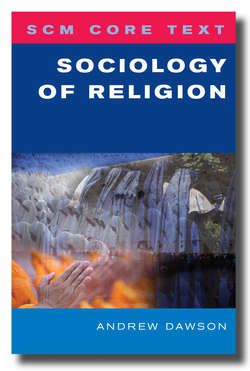Читать книгу SCM Core Text Sociology of Religion - Andrew Dawson - Страница 15
На сайте Литреса книга снята с продажи.
Key dimensions of society
ОглавлениеAs indicated above, modern society is a complex, multifaceted phenomenon whose constitutive parts (themselves varied and complex) interact in a vertiginous number ways. By way of facilitating sociological analysis of society, its components and their interaction, sociologists often distinguish between what are commonly termed the ‘macro’, ‘meso’ and ‘micro’ dimensions of the social world. Reflecting their derivation from the Greek language, macro literally means ‘long’ or ‘large’ and refers to the large-scale, overarching structures of society; meso means ‘middle’ and denotes society’s mid-range, intermediate parts; and micro means ‘small’ and refers to the, usually face-to-face, interactions between individuals which form the bedrock on which society rests. In their most apparent form, macro-structures take shape as economic (e.g. financial exchange), political (e.g. the state) and juridical (e.g. laws) processes which orchestrate the interaction of social institutions and the individuals who populate them. At the same time, though, macro-structures also exist as value systems (e.g. morality), dominant beliefs (e.g. religion), normative tastes (e.g. humour), and prevailing expectations (gender) which pervade the social world. In so doing, these symbolic structures influence both how individuals act (e.g. dieting, consumption, sexism, racism) and how institutions operate by way of, for example, access and exclusion (e.g. marriage) and reward and sanction (e.g. discrimination).
The intermediate dimension of society is occupied by a wide variety of institutions which, like aforementioned macro-structures, are more or less apparent to the untrained eye. In contemporary urban-industrial society, perhaps the most obvious institutions are those of education (e.g. school and university), employment (e.g. factory and supermarket), finance (e.g. banks and credit agencies), commerce (e.g. business and retail outlets), and state (e.g. local and national government, police, law courts, prisons). Less obviously ‘institutional’, but no less important because of it, are the institutions of family, interest-group (e.g. union and guild), voluntary association (e.g. uniformed organization) and religion (e.g. Christianity, Islam, Judaism). In sociological terms, institutions are not necessarily made of bricks and mortar, nor need they be constituted by law or have written codes of conduct with clearly defined roles and responsibilities. Rather, and basically put, institutions exist as collective modes of social organization whose members behave and interact in relation to a range of expectations as to, for example, their roles (e.g. lecturer or student, priest or parishioner) and status (e.g. learned or learner, ordained or lay). Different institutions exist in different forms, last different lengths of time and are organized more or less formally.
The micro-dimension of society comprises the myriad interactions which occur between individuals as they go about their daily lives. Sociologically speaking, what is most interesting about the daily interactions which comprise the micro-dimension is that they always involve more than the straightforward exchange between two or more people at any given time or place. In effect, and despite appearances, the everyday interactions from which society springs are influenced by a range of processes and dynamics which frame these social encounters and impact directly upon them to shape, pattern and organize their character in ways which transcend the conscious intentions and immediate awareness of the individuals involved. This is the case because every individual who inhabits society is shaped by a diverse array of influences which are mediated via the institutions through which she moves and the macro-structural processes to which he is exposed. Who we are as selves is, according to Richard Jenkins, ‘altogether individual and intrinsically social . . . Even though it is the most individualized of identities . . . selfhood is absolutely social’ (1996, p. 50). While a number of academics have contributed greatly to analysing the day-to-day interactions through which human beings construct their social world, what makes this analysis truly sociological is its theoretical linkage with broader concerns relating to the institutions and structures which frame all aspects of interpersonal encounter.
